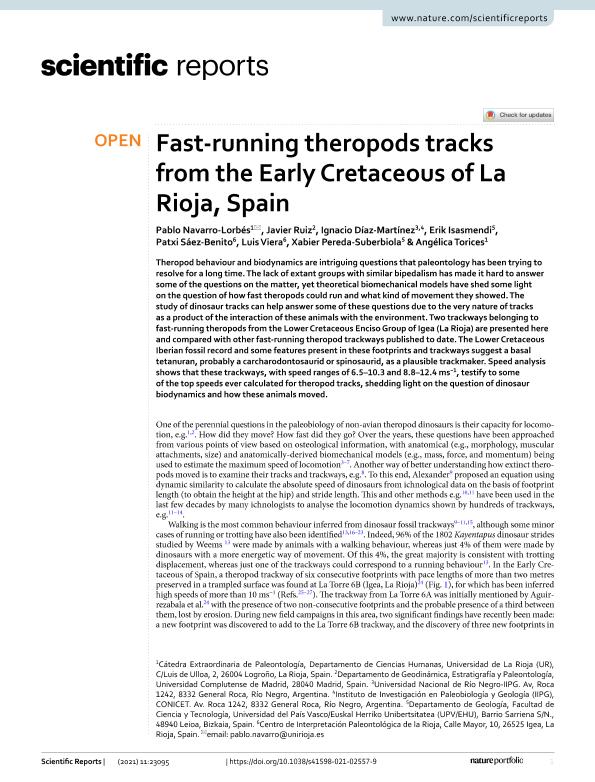Mostrar el registro sencillo del ítem
dc.contributor.author
Navarro Lorbés, Pablo
dc.contributor.author
Ruiz, Javier
dc.contributor.author
Díaz Martínez, Ignacio

dc.contributor.author
Isasmendi, Erik
dc.contributor.author
Sáez Benito, Patxi
dc.contributor.author
Viera, Luis
dc.contributor.author
Pereda Suberbiola, Xabier
dc.contributor.author
Torices, Angélica
dc.date.available
2023-01-06T18:36:26Z
dc.date.issued
2021-12
dc.identifier.citation
Navarro Lorbés, Pablo; Ruiz, Javier; Díaz Martínez, Ignacio; Isasmendi, Erik; Sáez Benito, Patxi; et al.; Fast-running theropods tracks from the Early Cretaceous of La Rioja, Spain; Nature Publishing Group; Scientific Reports; 11; 1; 12-2021; 1-13
dc.identifier.uri
http://hdl.handle.net/11336/183804
dc.description.abstract
Theropod behaviour and biodynamics are intriguing questions that paleontology has been trying to resolve for a long time. The lack of extant groups with similar bipedalism has made it hard to answer some of the questions on the matter, yet theoretical biomechanical models have shed some light on the question of how fast theropods could run and what kind of movement they showed. The study of dinosaur tracks can help answer some of these questions due to the very nature of tracks as a product of the interaction of these animals with the environment. Two trackways belonging to fast-running theropods from the Lower Cretaceous Enciso Group of Igea (La Rioja) are presented here and compared with other fast-running theropod trackways published to date. The Lower Cretaceous Iberian fossil record and some features present in these footprints and trackways suggest a basal tetanuran, probably a carcharodontosaurid or spinosaurid, as a plausible trackmaker. Speed analysis shows that these trackways, with speed ranges of 6.5–10.3 and 8.8–12.4 ms−1, testify to some of the top speeds ever calculated for theropod tracks, shedding light on the question of dinosaur biodynamics and how these animals moved.
dc.format
application/pdf
dc.language.iso
eng
dc.publisher
Nature Publishing Group

dc.rights
info:eu-repo/semantics/openAccess
dc.rights.uri
https://creativecommons.org/licenses/by/2.5/ar/
dc.subject
Running trackway
dc.subject
Theropod
dc.subject
Lower Cretaceous
dc.subject
Cameros Basin
dc.subject.classification
Paleontología

dc.subject.classification
Ciencias de la Tierra y relacionadas con el Medio Ambiente

dc.subject.classification
CIENCIAS NATURALES Y EXACTAS

dc.title
Fast-running theropods tracks from the Early Cretaceous of La Rioja, Spain
dc.type
info:eu-repo/semantics/article
dc.type
info:ar-repo/semantics/artículo
dc.type
info:eu-repo/semantics/publishedVersion
dc.date.updated
2022-09-20T10:47:47Z
dc.identifier.eissn
2045-2322
dc.journal.volume
11
dc.journal.number
1
dc.journal.pagination
1-13
dc.journal.pais
Reino Unido

dc.journal.ciudad
Londres
dc.description.fil
Fil: Navarro Lorbés, Pablo. Universidad Nacional de La Rioja; Argentina
dc.description.fil
Fil: Ruiz, Javier. Universidad Complutense de Madrid; España
dc.description.fil
Fil: Díaz Martínez, Ignacio. Consejo Nacional de Investigaciones Científicas y Técnicas. Centro Científico Tecnológico Conicet - Patagonia Norte. Instituto de Investigación en Paleobiología y Geología; Argentina
dc.description.fil
Fil: Isasmendi, Erik. Universidad del País Vasco; España
dc.description.fil
Fil: Sáez Benito, Patxi. Centro de Interpretación Paleontológica de la Rioja; España
dc.description.fil
Fil: Viera, Luis. Centro de Interpretación Paleontológica de la Rioja; España
dc.description.fil
Fil: Pereda Suberbiola, Xabier. Universidad del País Vasco; España
dc.description.fil
Fil: Torices, Angélica. Universidad Nacional de La Rioja; Argentina
dc.journal.title
Scientific Reports
dc.relation.alternativeid
info:eu-repo/semantics/altIdentifier/doi/http://dx.doi.org/10.1038/s41598-021-02557-9
dc.relation.alternativeid
info:eu-repo/semantics/altIdentifier/url/https://www.nature.com/articles/s41598-021-02557-9
Archivos asociados
